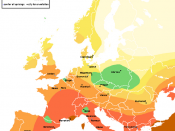Andrew Westbrook
28577
D'stoli
Essay #2
2/28/2003
AIDS & the Bubonic Plague
The destruction and devastation caused by the "Black Death" of the Middle Ages was a phenomenon left to wonder at in textbooks of historical Europe. An unstoppable plague swept the continent taking as much as eighty percent of the European population. However, today the world is plagued with a similar deadly disease. The AIDS epidemic continues to be incurable. In his essay (entitled "Bubonic Plague: Historical Epidemiology and the Medical problems") David Herlihy compares the historical bubonic plague with the current AIDS epidemic of today. According to his research, AIDS will probably prove to be the plague of the millennium. If one compares the epidemiology and social impact of the disease they prove to be quite similar. The current AIDS epidemic has the potential to be the most dangerous and destructive plague of the millennium.
No one knows exactly how the AIDS virus erupted. However, one presently dominant theory states the AIDS originated from monkeys in Africa that transmitted the HIV virus to humans through bites. As people migrated, it reached Haiti and then spread to America. The bubonic plague, too, was a spontaneous epidemic. The Black Death occurred because a bacillus was carried by fleas that fed off the blood of humans and transmitted the deadly bacillus in the process. It began in China and spread by migration throughout all of Europe and even America. Efforts to contain both diseases were entirely unsuccessful. AIDS is now an international problem as was the bubonic plague.
Like the bubonic plague did in the Middle Ages, AIDS is spreading at an alarming rate. In 1994, seventeen million people around the world were infected with the HIV virus that causes AIDS, and four million people have developed...


